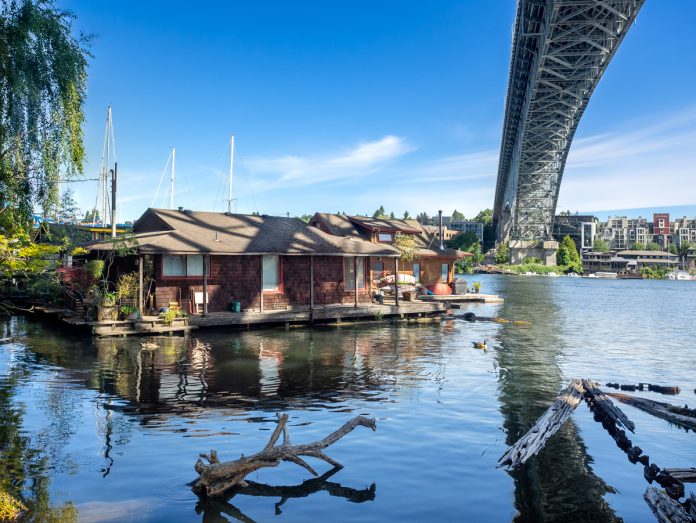
A 2010 article from the Seattle Post-Intelligencer reveals the crux of the bridge’s safety problem: “Lane width on the bridge from west to east is 10 feet, 9 feet, 9.5 feet, 9.5 feet, 9 feet and 10 feet. The speed limit is 40 miles per hour, though drivers often break that.”
I am a frequent advocate for urban lane widths less than the rural highway standard of 12 feet (which is WSDOT’s preference); down to 10 feet is ideal for city streets, but 11 feet is fine for routes frequented by buses and heavy trucks. Anything less than 10 feet at highway speeds is dangerous. Additionally, roadways with more lanes encourage drivers to break posted speed limits.

Early eyewitness reports indicate the two vehicles were traveling in opposing directions before the crash, although it is unclear what lanes they were in. One rumor is the Duck vehicle blew a tire. Regardless, with the opposing lanes only 9.5 feet wide, other lanes as narrow as 9 feet, and without a central barrier on this high volume, high speed roadway, the type of collision that happened Thursday morning was inevitable. The fact that both vehicles involved were wide (buses are 8 to 9 feet wide) multiple-passenger vehicles compounded the chance and horror of this collision.
I’ve been considering making this post for some time, but today it is suddenly and unfortunately relevant. The solution to preventing this from happening again is simple: rechannelize the lanes on the bridge and add a central barrier like the rest of Aurora Avenue. The resulting extra space must be used to widen the bridge’s sidewalks for safe passage by people walking and bicycling, and could also be used to provide a wider median than proposed. A best guess of the current design and one possible redesign is illustrated below. Other possible solutions are to channel the roadway into five lanes, with the center lane being reversible based on traffic flows using signals or a movable median barrier. This is what is done on the Golden Gate Bridge in San Francisco (see this video of how it works) and the three-lane Lions Gate Bridge in Vancouver, B.C.
Other possible solutions are to channel the roadway into five lanes, with the center lane being reversible based on traffic flows using signals or a movable median barrier. This is what is done on the Golden Gate Bridge in San Francisco (see this video of how it works) and the three-lane Lions Gate Bridge in Vancouver, B.C.
 If these aren’t enough options, the official recommendations from WSDOT’s 2003 corridor study should be implemented. The study says, “The lanes are so narrow that buses and other large vehicles sometimes straddle two lanes while traveling on the bridge. The combination of narrow lanes, lack of a median barrier, and driver actions (speeding, following too close, etc) creates a risk for sideswipe, rear-end and head-on traffic accidents.”
If these aren’t enough options, the official recommendations from WSDOT’s 2003 corridor study should be implemented. The study says, “The lanes are so narrow that buses and other large vehicles sometimes straddle two lanes while traveling on the bridge. The combination of narrow lanes, lack of a median barrier, and driver actions (speeding, following too close, etc) creates a risk for sideswipe, rear-end and head-on traffic accidents.”
The study suggests, “The proposed bridge improvement (Figure 6-6) would widen the lanes from 9.5 feet to 11.5 feet for the curb and inside lane and 11 feet the middle lane. A median barrier would be added to the bridge and approaches, and would connect to the existing barriers at the N. 38th Street and the Halladay Street intersections. The proposed additional lane widths and median barrier would require relocating the sidewalks below the bridge deck. In addition, the sidewalks would be widened to 10 feet to provide for multiple users and non-motorized vehicles.” The Seattle Times reports that Washington state lawmakers did not provide any funding to pursue these changes.

Issues of traffic congestion and cost are insignificant compared to the potential and realized loss of life on this bridge. The state has shown a willingness to improve the bridge already; in 2011, a $4.8 million suicide barrier was built along the edges of the bridge. In the long term, the Aurora Bridge likely needs to be expensively retrofitted or completely rebuilt (which the WSDOT study estimates would cost $200 million in 2003 dollars). It is over 80 years old and functionally obsolete.
A safety redesign will fulfill Seattle’s Vision Zero strategy for eliminating traffic deaths and serious injuries by 2030. Reconfiguring the Aurora Bridge will be one of many big steps towards improving traffic safety in Seattle. Local and state leaders must act now to prevent today’s tragedy from happening again.
This article is a cross-post from The Northwest Urbanist.
Scott Bonjukian has degrees in architecture and planning, and his many interests include neighborhood design, public space and streets, transit systems, pedestrian and bicycle planning, local politics, and natural resource protection. He cross-posts from The Northwest Urbanist and leads the Seattle Lid I-5 effort. He served on The Urbanist board from 2015 to 2018.

